Google’s Search Generative Experience:
What It Means for Your SEO Strategy
Recorded Thursday, November 2
With Google testing AI-generated content in its search results, the SERPs as we know them are about to change – and so should your SEO strategy.
Here at Inflow, we’ve been keeping a close eye on the beta SGE feature that Google has been experimenting with over the last few months. In our upcoming webinar, we’ll share our team’s take, including:
- What you can expect from an SGE future
- How your organic performance will be affected
- What you should be doing to prepare your marketing teams, SEO strategy, and website content
Speakers

Jen Holzman,
President


Lindsay Haskell,
Sr. SEO Strategist

The video below is hosted on YouTube. If you need assistance with viewing the video, please contact info@goinflow.com.
Video Transcript
Kate Miller, Content Marketing Manager:
We’re excited to have you here and excited to talk about Google’s Search Generative Experience and all of the things that we’ve been discovering and keeping an eye on, and being able to share with you what we’ve been coming up with here at Inflow.
Here at Inflow, we’ve been keeping a close eye on all SEO developments, but specifically on the SGE feature that Google has been beta-testing over the last few months. We’ve been coming up with some strategies and tactics and recommendations for our clients, and we wanted to share some of those with you today in our webinar.
Our SGE Experts
Today, we have two experts from Inflow who will talk us through Google’s Search Generative Experience: what it means for your SEO, the things we’ve been discovering here at our agency, etc.
Our two experts that we have today are Lindsay Haskell, who’s a senior SEO strategist here at Inflow. She’s been here since 2019. She helps develop, implement, and strategize SEO for a variety of our client sites.
We also have Jen Holzman, who is our president. She leads the team in understanding some of these industry developments, making sure that we are putting together the strategies and the approach that will help our clients stay ahead and keep growing and achieving their business goals, even as the industry is changing around them.
About Inflow
A little about us, for those who don’t know: We are a full-service digital marketing agency, full-service SEO agency. That means everything from technical SEO solutions to SEO content marketing audits, all that fun stuff in between, as well as the GA4 stuff that’s required to be making sure that your SEO analytics are running well.

We have more than 15 years experience in this field, and we also are Search Engine Land Award winners. We won for Best Overall SEO Initiative, Small Business.
Webinar Topics
So, as it’s been alluded to over the last few minutes, we are covering Google’s Search Generative Experience and what it’s going to mean for your SEO strategy moving forward. We’re going to cover everything that we’ve kind of been learning here at Inflow and developing for our clients.
So, we’ll start off with explaining what SGE is, what you can expect, how it works, what that means for the future of the SERPs — as well as some strategies to help your brand stay at the top of the organic performance and make sure that your brand awareness is out there in the SERPs, and how you can adjust your SEO strategy to make sure that your performance maintains, even as these SERPs continue to change in the future and all of the unknown things that are awaiting us.
We’ll be going through some branding strategies and eCommerce strategies, as well as some strategic opportunities that SGE is going to open up for us.
We will also have a Q&A towards the end to answer any of the questions or address any of the comments that come up along the way.
So, without further ado, I’m going to pass this off to Lindsay, who’s going to walk us through the basics of SGE and what it means for you all moving forward.
What is Google SGE & How Does It Work?
Lindsay Haskell, Sr. SEO Strategist:
We’re going to start with just explaining what SGE is.
As Kate mentioned, it stands for Search Generative Experience, and it’s essentially Google trying to utilize AI more and showing AI content at the top of the search results.
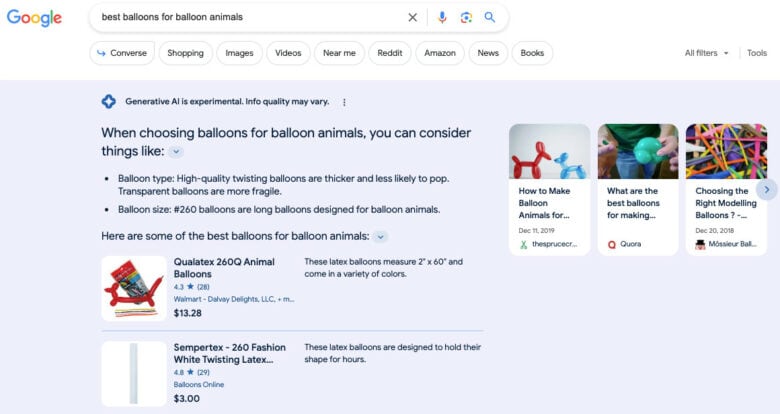
We’re seeing different placements of the links and what the experience is within those AI-generated snippets, which we’ll go into in more detail.
Unlike previous SERPs, they are generated by Google’s AI chatbot. So, it’s not pulling from a specific site.
Previously, we’ve had featured snippets that show something from a specific site and a link there. This is created by AI or generated, and then including often informational (and transactional) links, depending on the query.
That’s on a basic level what it is.
Jen Holzman, President:
One other thing to note, Lindsay, with where it is and what it is, right now: It’s in beta, right.
So, the screenshots that you’re seeing are from our team because we’ve opted into the beta test that Google is running on this. Although you may not see that in your SERP, it is live and available for users to see if they opt into this experience during testing.
So, that’s what you’re seeing in these images. If you haven’t seen that before, or maybe you’ve played around with it already, opting in is how people are experiencing this right now.
Lindsay Haskell, Sr. SEO Strategist:
Google has not announced a release date. So, as you mentioned, it’s in beta testing; we don’t know when it will be released.
We also don’t know what it will look like in a finalized format. For example, when they were first testing it out, the full snippet was right available at the top.
Now, they’re using more of a “show more” for at least most of the queries, like a “show more” button that you can then click to see the full snippet. So, that’s less intrusive to our usual search results that we’ve seen.
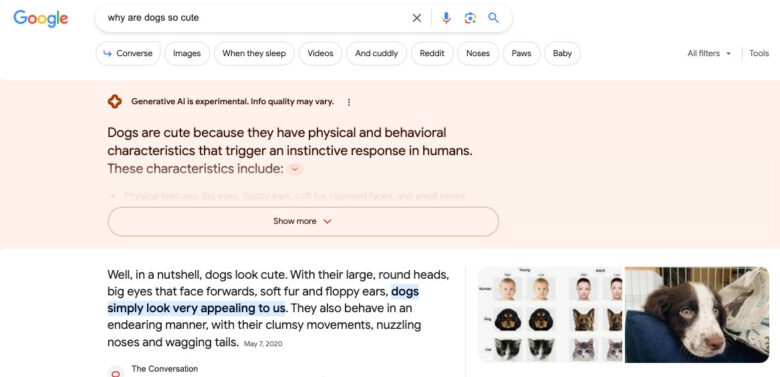
As we’ll go into a little bit more, when we get to how it might affect paid, we’re often seeing ads at the top as well.
Or we might see this snippet further down the page. So, they’re really testing out where they want it to be.
We don’t yet know what kind of form it’ll actually be released in or when it will. They haven’t announced either of those. But we’re keeping an eye on it.
From what we do know and some of the consistent things we’ve seen as we’ve gone through the beta version, there’s still some takeaways and action items that are good and important to jump on.
SGE SEO Strategies: Branding Efforts
One of the big changes we’re going to see is branded search.
What I mean by that is when you put in your brand name, what comes up. This is a pretty big change and could have a big impact. As we know, branded terms are very important.
So, taking a look at what that looks like:
We’re seeing a lot of AI content explaining, for example, in this case, what the company does, what its services are. Oftentimes, sometimes it’ll mention items about what the reputation is.
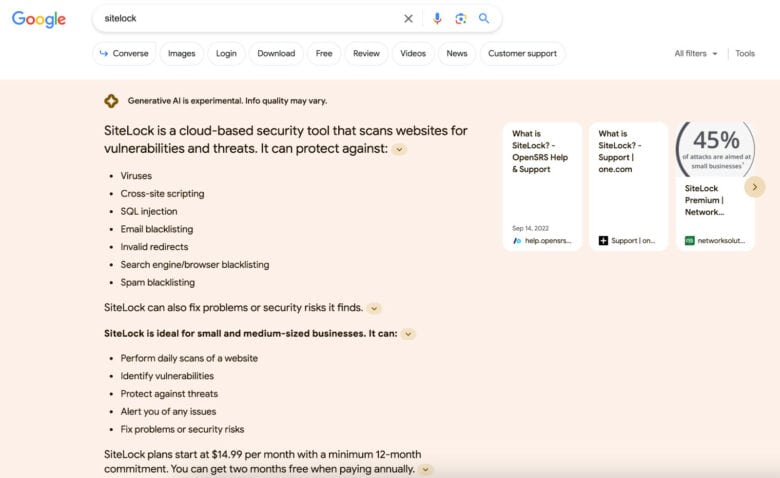
As we mentioned, this is AI content. So it’s a compilation; it’s pulling from a lot of different sources. It’s not just coming from your sites or your own assets; it’s also coming from outside of that.
That makes online reputation very important, since this is the first thing people may see when they search your site.
We also see that Google does include links there. Sometimes they also include links to your site within the snippets, but oftentimes they will include links to your site and third-party sites.
That’s another change from what we expect, where, at least in an organic search, when you get past the paid ads, you are likely to see your site first. That’s exactly what users are seeing first, whereas here in SGE, they might see all these links closely and and choose one of the others.
That’s a big shift that you want to be prepared for and have some strategies to deal with that.
In this example, there aren’t ads at the top, but oftentimes we do see ads at the top, which, as we’ll go into later, makes bidding on branded terms definitely already important but could increase in importance, depending on what this ends up looking like
Jen Holzman, President:
Great point, Lindsay.
I think this is one of the biggest shifts for brands. If you already are working with online reputation management strategies, tools, social listening tools, these are going to become really important. You want to have your pulse on how people are talking about your brand, because that’s what generates this content.
I know we’re all pretty familiar with how ChatGPT and Bard are coming up with these answers, but they’ve scoured the web learning about millions and billions of topics, and how they’re doing that is pushing together information from lots of different sources. And, when they do that, they’re going to listen to whatever they’re out there scraping.
If you’ve gotten some ORM issues popping up, or maybe something in the past that you were working on kind of suppressing or riding the ship on, then these are things to pay attention to when it comes to influencing these brand terms definitely.
You want to keep your finger on the pulse of the online reputation management and influence that in any way possible, working with PR companies, especially those that are familiar in the digital space. Link-building through SEO is also important.
There’s a lot to go into making sure that you show your best face in this AI space. And we’ll go through some of those tactics as well.
Lindsay Haskell, Sr. SEO Strategist:
As Jen mentioned, online reputation is going to be really important — the reviews on third-party review sites, things like that.
Even though it’s not pulling just content from your site, it’s still important to make sure you have brand-specific content that speaks to what you do and highlights your value propositions, so Google does have that from your site as a resource.
You also want to make sure you’re using structured data, schema markup, to provide more details on what your organization is, and links to your social profiles in there.
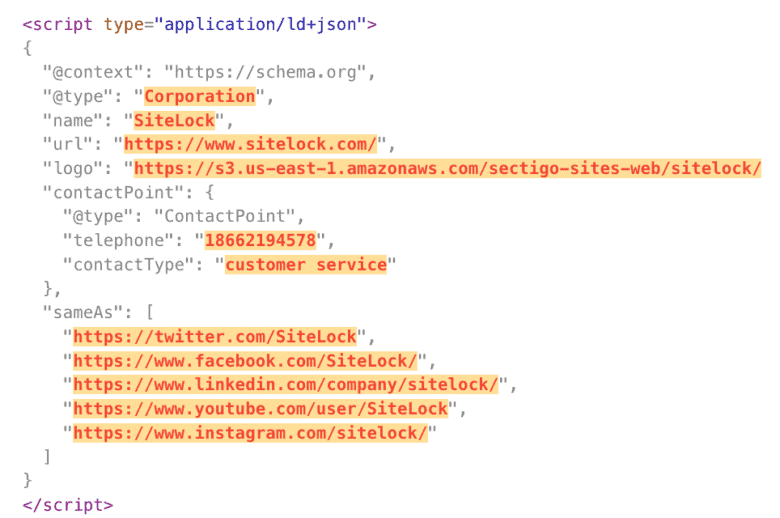
The more information you can provide Google will help to make sure your branded searches are still looking good in the snippet.
SGE SEO Strategies: eCommerce Efforts
As we go into eCommerce, this is another industry where we’ve seen a lot of shifts, from what we can see so far in the beta testing.
One example that we looked at is when we searched “used camera.”
As you can see here, there’s an AI snippet of what to consider when you’re buying a used camera, and then informational links to the right there on desktop, and then also a shopping experience where they’re linking to specific products and going to those Google results of the products oftentimes beneath there.
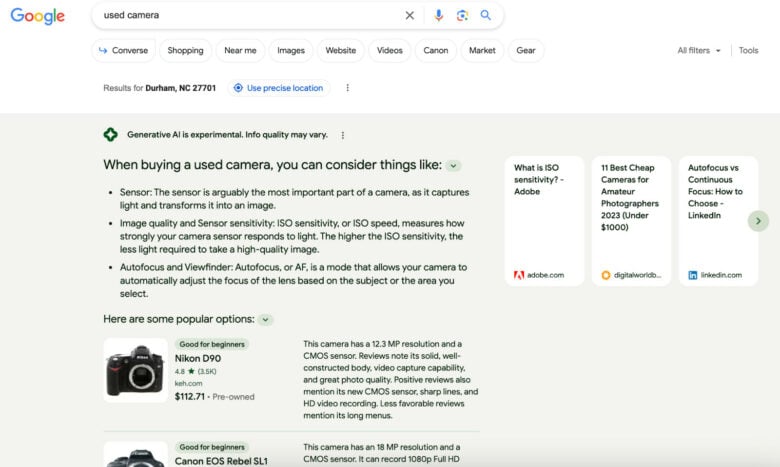
So, this is a a very big change.
We likely will see ads at the top, but typically we then see category pages coming up for these from specific sites for people to click through. So, this is definitely a big change.
Having that information come up is a little more unusual for a query like this. In addition, typically, especially for a broader query like used cameras, it’s very broad. We wouldn’t typically see, right at the top, product pages.
So Google, from what we can see, is looking to bring that shopping experience within their search results.
And so product pages are going to be coming up more for certain broader terms, where we might expect category pages. Category pages will likely also rank, but depending on how people interact with this kind of snippet, we’re often seeing product pages within the snippet there.
You can also see that, for example, in the product page part or in the products part, Google has little tags that are “good for beginners” and ones like that, and coming up with images within there, so those are a couple of changes, as well.
So, this is a really key strategy for eCommerce businesses: the product pages. They’re always important, but often for those broader terms, category pages will still be important, but it wasn’t typically coming in with these product pages.
As we might expect them to come in the snippets more, we really wanna make sure we’re focusing on product page optimizations — making sure those pages are built out, really highlight the features and benefits. Google isn’t pulling in, from what we can see, those tags from a page. So, having like tag “best for beginners” isn’t going to bring it in.
But the more information you can provide about a product and its benefits and its features, that’s gonna further inform Google. That includes product and review schema markup, as well, to make sure they have that information.
Make sure your images have image SEO best practices. For example, on a basic level, making sure they have alt text that’s clear what the product is, and then image SEO — the file descriptions, file names, things like that.

We see there are informational links coming up more for these queries. Making sure you have content that fills those needs is gonna be very beneficial, so that can be building out hub and spokes around specific products — like, you have the Nikon D90 and potentially doing longer-tail keyword strategies around that product or those types of products, as well, will be really valuable.
Jen Holzman, President:
An example there for folks that aren’t familiar with the hub-and-spoke strategy: The Nikon D90. Well, what is that used to shoot? Is it used to shoot weddings? Is it used to shoot landscape?
You’d build out content around that that’s related to the product that you’re focused on.
But it’s tangentially connected, right, so we’re trying to give more information about that product and how it’s used in the real world.
That is the hub — the product. The spokes around it being all the information about how it’s getting used.
It’s a common strategy we like to use here to really build up and beef up these product pages and how they’re interlinked on the site, as well.
SGE SEO Strategies: Content Efforts
Lindsay Haskell, Sr. SEO Strategist:
Then, we get to strategic content. What we mean by that is more informational queries, where you would often have different resources or different blog articles coming up for for these terms.
So, if we look at a comparison of what we see for one term here, which is “how to digitize photos,” this does have a featured snippet.
If we look at the old one — our current one, I guess, right now, but it’s going to be old, potentially — we can see there’s a featured snippet, but it’s pulling directly from that site, and then you can click on that site.
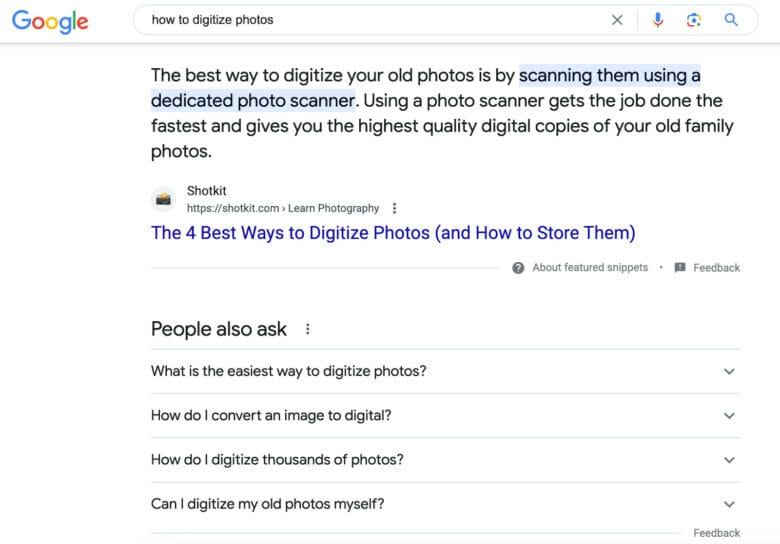
The new one has the AI content there, answering the question in a lot more detail, and then it does have articles linking off to it. But you can see that it’s Google’s content they’re using versus a featured snippet that links to one page.
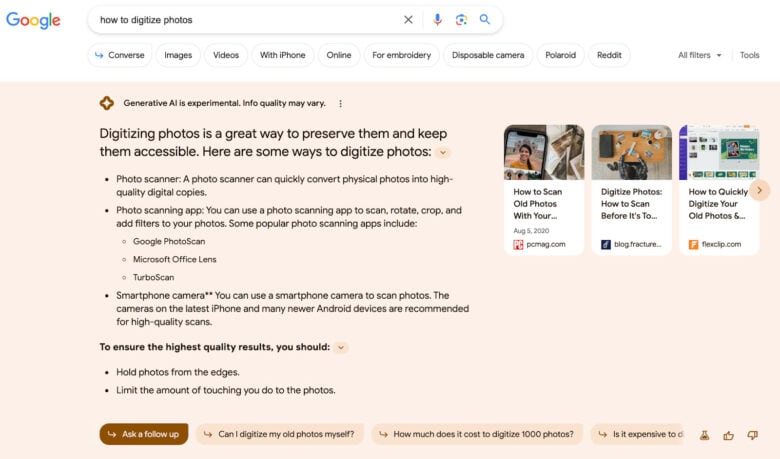
In addition, they have “people also ask” right now in a different format at the bottom of the snippet versus how we usually see it.
When we right now click on like the old “people also ask,” it’ll come up with a little answer and a link. For the new one, it often will bring you to the new search result in that snippet for that question.
So, that will be a different experience to keep in mind, to see how we can also come up for some of those longer-tail queries and questions.
Jen Holzman, President:
One of the things that we noticed, too, on those snippets: We learned not so long ago from Google that things like FAQ schema wasn’t going to result in the same type of accordion menu, that we were able to take up more real estate on the SERP in the past.
They were gonna deprecate that and what that leads me to believe is that they’re trying to make some real estate on the SERP. It’s not going to live at the top, as you’ve heard us say a few times. It probably will find its way lower on the page where some of those snippets used to be.
So things that we optimized for — some will remain, and others will probably have this SGE billboard, if you will, replacing them, because Google’s put a lot of testing in where to put something interactive on the SERP page. They’ve learned a lot about where they’re gonna get the most action.
And so we can hypothesize that this banner, this very colorful interactive banner, is probably going to make its way down on the page somewhere where we would have seen the FAQ schema markup bringing up an accordion menu, or the “people also ask.”
So, when we hypothesize about where this is going to end up, some of the hints are in what is going away at Google, as well.
Lindsay Haskell, Sr. SEO Strategist:
One concept that has always been important, but is expected to increase in importance, is the EEAT — so, showing the experience, the user experience or the experience on the page, as well as expertise and authoritativeness and trustworthiness.
There’s a lot of AI content out there, as we know, and increasing. To help influence what Google pulls in to their content and their links, being able to stand out with expertise is going to only increase in importance from what we’re expecting.
And, so, making sure we’re taking the steps for that:
For example, especially for more technical fields or ones that require expertise, one is having author pages that explain why is this person qualified to talk about this topic.
Also, on your site, make it clear you’re a legitimate business and have that experience, as well.

So, those have always been important, especially with different algorithm updates over the years — but it’ll just continue to be and likely increase.
It’ll be interesting to see how it impacts standard keyword research that we currently do as there’s already the limitations with search volume and certain tools as they pull from a full year’s worth of data usually, and then average that out — versus seeing how Google is generating these answers, and how we can adapt on a quicker level with Google trends and what we’re seeing, as well as the changes to “people also ask,” those longer-tail queries, etc.
So, that will likely change and evolve, so that’s something we’ll be having our eye on as this is released in the future.
Kate Miller, Content Marketing Manager:
I will also note that the case study that we won an award for involved EAT SEO, specifically for that kind of medical field. If that is something that is relevant to your site or you’re interested in learning more about, you can check out that case study, and that’ll give you a better idea what EAT SEO is and some of the strategies and tactics that are there to help you make your site more authoritative.
SGE: How Will It Affect Google Ads?
Jen Holzman, President:
We’ve talked about this throughout, but right now we’re in testing mode. At first we weren’t seeing any paid ads above the SGE banner. That is just something that we can’t believe, because Google always prioritize its revenue stream. There’s no way that shareholders would be very happy with pushing Google Ads down the page underneath a colorful, fun-to-interact-with, lots-of-links banner.
So our thoughts are — I’m not on the product team — that the ads will remain at the top. We don’t believe that Google is banking on a scroll depth of 3 or 4 thumb thumb-flicks or several clicks down the page to get to that. We do believe that the ads will be at the top.
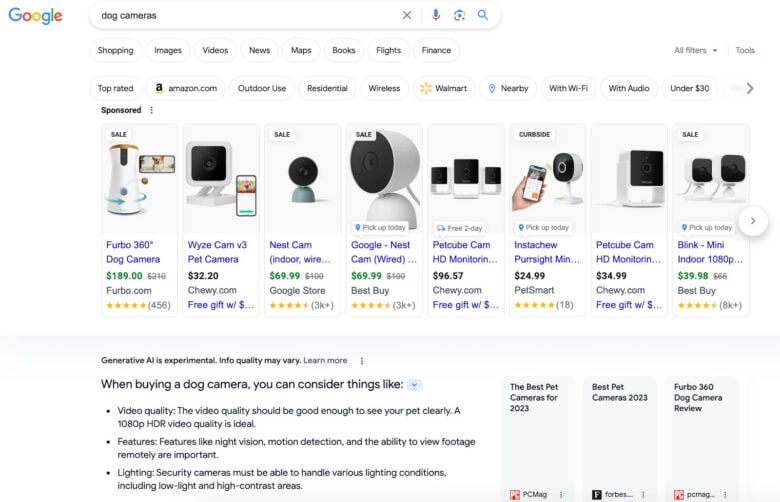
Lindsay started with some brand strategies and mentioned this at the top: bidding on brand. Some brands love it, right? You have to do it. It’s part of the funnel. We want to make sure that we’re there. We want to compete against our competitors who are going to buy our brand terms.
Other brands have a real philosophy against bidding on their own branded terms. And I think that might be up as far as a philosophy goes.
We want to make sure that, when an SGE result is released, if it does come out in some of these forms that we’re seeing, that the links to other properties coming up when someone searches your brand term aren’t what’s available first.
So, having a branded campaign strategy ready to roll out, and some ideas around budget and things like that that you want to test into when SGE starts hitting the live SERPs, is going to be an important part of the strategy moving forward.
Typically, your brand terms are not the most expensive terms. So it shouldn’t break the bank, and it is going to be an important way to protect traffic to your site after this release.
Some other things that are more related to eComm:
First, you know, I do think eComm is going to experience a lot of this change. Google is liking playing with the products in SGE. Lindsay had some great examples of that with the PDP pages being pulled in there, being able to categorize them.
I imagine that Google’s going to have a lot more of those results available than when they are something that has to do with Your Money, Your Life — things that are a little bit more dicey to leave up to AI. So, if you’re in a medical field and looking for lead generation, it might have a lesser impact than someone who is selling a product online.
So for those in the eComm space, it is going to be important to make sure that your Google Merchant Center is up and running, that you have control over it or an agency in charge, and that your product data feed is ready to go, inputting your products in there. That’s going to increase the chance of getting organic product listings appearing in SGE, if they end up putting those organic listings in there.
For those not familiar, Google does have some free shopping listings that are generated through the Google Merchant Center, and you can track those in there. It will be important to get all your products uploaded in there, whether through a data feed through the back end of your Shopify or just a static feed that you download and then upload to that center.
You also just want to hook up everything you can. So, Google Search Console to Google Ads, make sure your Google Ads is hooked up to your Google Analytics. You want the whole Google ecosystem from a data perspective to be talking to each other. This is kind of a strategy outside of SGE.
But I think it’s also gonna help give you some data and information moving forward for optimizations within shopping. And, as we progress into this being in a live space, maybe Google starts offering ads in this box.
So, you want to be prepared with having your products up and ready to go there.
I think, really, that hits on the main points for PPC, as far as it’s concerned. Again, Google’s not going to take their revenue stream and push it down the page.
So really, this is about just making sure that you’ve got a strategy to stay up there and be visible.
Final Takeaways & Recommendations
We talked about a lot that’s in a beta, right? So, we’re still learning. We’re always testing, and we love when we’re able to test something that’s not fully live yet. It’s going to be an important shift in how the Google SERPs look.
Both Lindsay and I have been in SEO for over a decade. We’ve been through large shifts in the SERPs before. The most important thing to know about SEOs is that we don’t scare easily. We know that Google tests things at a large scale and then often pulls back what they’re actually going to release.
All that said, we want to be proactive. We want to be flexible. You want to have a roadmap with your SEO agency or team that is putting priority on some of the things we’ve discussed today, things that are core to SEO already: schema markup, making sure your images are optimized.
These are things that are important, anyway, but just become a little bit more of a priority as we move closer to something like this being released.
So this isn’t an alarm. This isn’t a fire drill, but it is time to prioritize getting some of these things in place and having a plan.
The other big thing is 2024. Planning is already coming up. I’m sure some of you are in budget talks or already wrapping some of those up. It’s important to know that SEO is going to have to be part of those conversations, and that KPIs might need to be flexible moving into 2024.
If a big billboard lands on top of everything, as we saw in some of those SERP results, click-through rate further down the page is going to go down. You’re going to see a decrease in site traffic overall. But that will be not only to you; it’ll be to your competitors, as well, as Google is giving that information prior to someone being enticed to click.
So, these are things to think about as you’re moving forward into 2024 planning.
I know Alex Juel on our SEO team, as well, has come up with some ideas about doing analysis on different top pages for traffic and making sure that you have a real good understanding about the pages that are driving your traffic right now, and planning for or doing some analysis on what might be affected the most as we move forward toward something like this.
Sometimes knowing brings comfort to all, and so doing some of those deep dives now can help you understand and expect what might change as this rolls out.
Q&A
Kate Miller, Content Marketing Manager:
If you’re struggling to figure out what you want to do with your SEO strategy moving into 2024, we’re always here to help. Just reach out anytime, if you have questions or anything like that.
I know it was a lot of stuff that we just covered in the last half hour, and it’s really quick. So we do recommend taking the time to do some experimentation in the SGE beta, and seeing for yourself exactly what’s going on, what may be happening, or what might be rolling out, and checking out some of those resource guides — just so you have a better idea of what we’re seeing and some of the top strategies and priorities moving forward.
So, that said, if you have any personal questions or comments or thoughts that you want to share or get our experts take on, this is the chance to do that.
How will SGE change SEO reporting?
Something that I would want to ask, after hearing Jen talk about how KPIs and whatnot are going to change, what would you recommend — for example, click-through rate starts going down, organic traffic starts going down — how do people build their SEO goals and metrics, when those metrics that we’ve been used to for so long are now maybe going to change drastically? And how do you measure your success?
Jen Holzman, President:
Great question. A lot of it remains unknown how much the impact is gonna be.
There’s great studies out there for quite a while with companies putting together average click-through rates based on position in the organic rankings, as well as paid listings, and taking learnings from that of knowing what percentage of folks are gonna click on the number one position versus number two, three, and so on — and then weaving in where we see those featured snippets is where we might be able to forecast some of this impact.
We could replace one of those boxes with one of the previous positions and try to estimate what we might be able to see going to that box versus your previous position. That’s something to look at.
The other thing to keep in mind is everybody who was using Google Analytics as their source of truth from a traffic perspective is now on GA4, and so the units of measurement have changed since July forward already. Something like this added to the SERP could change that again, so more so than trying to tell you exactly what that’s going to be, I guess I’m trying to warn that you won’t always be able to anticipate year-over-year growth in a way that maybe you had some steady traction going forward before.
This could result in some changes to how that appears, based on which queries were your money terms before and how prevalent SGE is moving forward in 2024.
Lindsay Haskell, Sr. SEO Strategist:
A lot is to be seen. Looking at what pages we think will be most impacted on a more granular level might also become important. It already is, but it also might be more of a focus on reports as we start targeting around or with SGE.
Jen Holzman, President:
Those top pages — really understanding where the traffic comes from, what are the queries that build that traffic. No page makes all the traffic and all the money from one search term. There’s a lot of terms that go into winning the traffic and revenue for that page.
So, understanding what the keyword footprint is for these top pages and then really diving into the SERPs and how they’re changing is definitely helpful there.
Is there any chance Google will not launch SGE?
Kate Miller, Content Marketing Manager:
You mentioned that the beta has been changing and Google’s been testing a lot of stuff. You talked about how it may not be as expansive as they’re testing right now, the live version when it launches. Is there any chance that Google may not move ahead with this, or may not decide to launch it?
Jen Holzman, President:
You want to put money on it?
Money comes to mind. I think there’s been a lot of investment in development hours that goes into something like this. And while that doesn’t make or break a decision to launch a product, I do think that a lot of time, money, and effort has gone into building this.
I also think that for the first time in a very long time, Google is chasing Bing. Bing has already released that AI experience within their SERP, and Google has been more cautious about releasing that — citing things that I do think are important, citing things like making sure to get the right information to people, the ethics behind AI, and what we’re releasing to the world from an informative standpoint.
But they are chasing Bing. And so I do think that this will likely be released.
I think they’re gathering a heck of a lot of data every time someone is looking at it and interacting with it now, and so it likely will change and will continue changing just like the SERPs now.
But, if I’m putting a bet on it, it’s coming out for sure.
What are your top-level thoughts and recommendations for SGE?
Kate Miller, Content Marketing Manager:
Curious, as we’re wrapping this up, kind of top-level thoughts from both of you: What are some of your biggest recommendations or the most important things that you would want people to keep an eye on as we’re moving forward?
Lindsay Haskell, Sr. SEO Strategist:
A lot of the big changes that I’m seeing are definitely branded, and that is a key, key revenue-driver. When people are searching for your site and learning about your site, I’d say that’s a a big priority.
With SEO, we always look at branded and non branded. There’s often a lot of focus on non-branded, which is still important, but also looking at some branded SEO strategies I think will be important.
And then, if you are an eCommerce brand, those product pages will definitely be important in seeing what those queries are. Right now, some of those big queries that are driving to your category page: you might see drops in your category page, but are you seeing increases in your product pages and tracking that?
I think those are maybe the the top two in my mind.
Jen Holzman, President:
I think those are great. I agree with them. I wouldn’t really mess with those, I think.
Getting your SEO strategy in place, hitting on those core elements that all of us SEOs have been harping on for a while — getting the dev tickets in early, making sure that your image optimization is up to speed will be important. I think the other thing is do some (or either work with your agency to do some) research on whether you think this is gonna impact.
Have some fun on ChatGPT and Bard, as well utilize those AI systems. Test your brand. What else is coming up? What articles do you think are getting pulled from, what answers are being provided by these systems might give you hints in what you might need to be combatting once that comes live.
You can tell I’m an eternal optimist about what these systems are gonna talk about your brand — it could be awesome! But you do want to make sure that you’re testing for something that might be a curve ball for you, so that you’ve got time to plan and strategize about a positive PR push, try to influence some of these things.
We know that it takes a lot of time to train an AI answer, and so the timeline is getting shorter. But you definitely want to do everything you can proactively to make sure you’ve got a positive sentiment out in the internet.
When do you think SGE will go live?
Kate Miller, Content Marketing Manager:
Here’s one from the Warehouse1 team, which is probably nothing that we can answer — but just wondering if there’s a guesstimate when SGE might roll out, whether it’s sometime in 2024 or later? Any kind of wild guesses you would want to throw at the wall there?
Jen Holzman, President:
I wish I wish I had a seat on the product team or a bug under the table. But I don’t. My guesstimate is 2024.
I don’t think this is gonna go past that; I also don’t see them releasing it prior to that, although we have seen some large algorithm shifts, like, right in the middle of December, before the end of the year sometimes as an SEO, so those are always a nice fun holiday surprise.
I would anticipate something in 2024. But we’re always keeping a pulse, trying to keep track of any kind of hints that might tell us otherwise.
I don’t know, Lindsay, if you’ve heard anything more recent than I have that would advise us any closer to a date.
Lindsay Haskell, Sr. SEO Strategist:
No, I agree with that. We have no idea, but I’m going to guess 2024. Maybe they’ll be rolling it out slowly. I mean, they are testing it out now, but I don’t know if it’ll be a hard launch or what, but my guess would be sometime in 2024 — or a fun December surprise.
How can you use the SGE beta to build a content/query strategy?
Kate Miller, Content Marketing Manager:
There was a quick question from Caroline, too, wondering if there’s a way to play around on ChatGPT, Bard or within the SGE beta to reveal what’s going on in the background or understand a little bit better how certain things are being pulle.? Have you found anything while you’ve all been looking at the data and testing it out?
Jen Holzman, President:
Well, there is the approach of using various prompts: “your brand plus reviews,” what’s the sentiment of “insert brand,” those sorts of things.
You can copy snippets of what is produced out of ChatGPT or whatever AI system you’re utilizing and slap that in Google and see if it’s getting scraped from somewhere.
There’s also a great article that came out several months ago about the websites that were used to help train ChatGPT OpenAI. It was really an interesting article; Inflow came up, and Inflow was hit a ton of times by the servers that were identified as going out and training about different information.
So, good to know that ChatGPT was trained by Inflow regarding SEO and PPC and CRO, because they want to go to the best. It was really interesting to to take a look at that.
What you could do is look for websites that you know in your industry in that list and see if you’ve got any articles or mentions on those sites.
Conclusion
Kate Miller, Content Marketing Manager:
It’s always cool to see what’s behind the magic, especially some of those sites, Inflow being one of them, where you can see where all this is coming from.
Definitely play around. Give it a try and see what comes up, how you can change, manipulate the queries to get what you’re looking for. Build a strategy around that.
Unless we have any more questions, that is going to wrap it up for us today.
As mentioned, we will be putting out some more resources as this all develops, especially whenever we do see the launch of SGE — you can bet we’ll be putting something out and getting some more strategies and tips and helps for all of you, as you’re navigating this new SERP landscape.
If you do have any questions or anything that comes up after the fact, we’re always happy to chat through some of those things, discuss some potential hypotheticals, make some wild guesses as to what Google’s going to do — have some fun with it.
Thank you again to Jen and Lindsay for your expertise and sharing all of this with us.
And thank you to all who attended. It was great to get to chat with some of you through the chat and help you understand a bit more about what we’re expecting here.
Hope you all have a great rest of your day.






